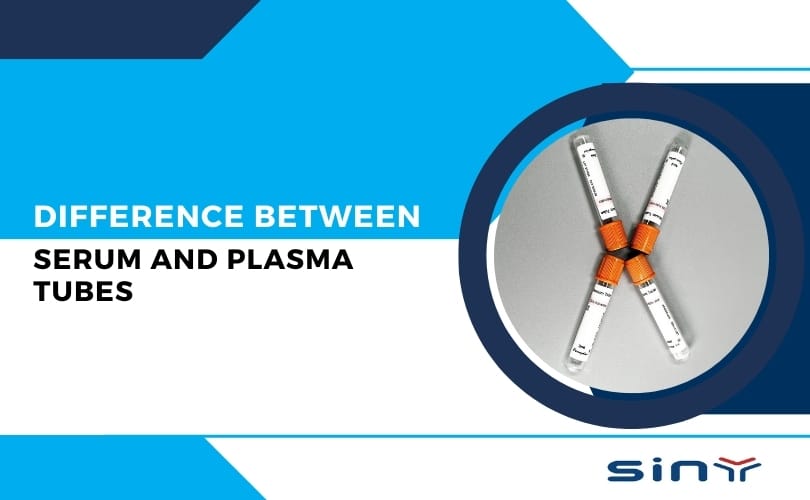A PRF tube, or Platelet-Rich Fibrin tube, is a specialized medical device designed to collect and process blood to produce platelet-rich fibrin, a second-generation platelet concentrate. This tube plays a crucial role in regenerative medicine by facilitating the separation of various blood components through centrifugation.
Table of Contents
What is a PRF Tube?
PRF is a second-generation platelet concentrate obtained by centrifuging whole blood. During the centrifugation process, the various components in the blood are stratified due to different densities, and substances such as platelets and fibrinogen gather together to form PRF.

PRF mainly contains platelets, white blood cells, fibrin, etc. After being activated, platelets can release a variety of growth factors, such as platelet-derived growth factor (PDGF), transforming growth factor-β (TGF-β), etc. These growth factors play an important role in tissue repair and regeneration. White blood cells are of certain significance in immune regulation and anti-infection, and fibrin provides a structure similar to the extracellular matrix, which is conducive to cell attachment, migration and proliferation.
What is the role of PRF tube?
The PRF tube specifically collects blood and prepares PRF. Its design facilitates blood centrifugation, ensuring effective separation of PRF. Different PRF tubes may differ in material, shape, centrifugal parameter requirements, etc. Moreover, other medical fields, such as plastic surgery and orthopedics, actively use PRF tubes as a versatile tool to promote tissue repair and regeneration.
In oral medicine, such as wound healing after tooth extraction and dental implant surgery, PRF can promote the repair of bone and soft tissue. The correct use of PRF tubes is essential for obtaining high-quality PRF, thereby ensuring the effectiveness of these clinical treatments.
What is the difference between PRF tubes and PRP tubes?
PRF tube-related components
PRF (platelet-rich fibrin) is prepared through PRF tubes. In addition to high concentrations of platelets, PRF also contains white blood cells and fibrin. Fibrin forms a loose three-dimensional mesh structure that wraps around platelets and white blood cells. The presence of white blood cells, a key component of PRF, not only enhances its healing properties but also makes it a potential player in immunomodulation.
PRP tube-related components
PRP tubes prepare platelet-rich plasma (PRP), which contains a high concentration of platelets, typically higher than in normal blood. However, PRP has relatively less fibrinogen compared to PRF, and the preparation process may remove white blood cells, particularly in more advanced PRP preparation methods.
Clinical application of PRF tubes
In the field of oral medicine, PRF is a go-to for wound healing after tooth extraction and tissue repair around dental implants, thanks to its white blood cell content that aids in wound repair with infection risks. In plastic surgery, PRF’s role in immune regulation and long-term tissue repair makes it a valuable tool for wound repair, especially in cases that require these specific functions.
Clinical application of PRP tubes
PRP finds its niche in situations where rapid and large-scale growth factor stimulation is needed. For instance, in the early treatment of osteoarthritis, PRP injection can deliver a substantial amount of growth factors to alleviate joint inflammation and foster cartilage repair. Similarly, in the early treatment of certain sports injuries, PRP can swiftly supply growth factors to expedite the repair of damaged muscles, tendons, and other tissues.

The preparation method of the PRF tube mainly involves the following steps
Blood collection
Collection Preparation
Select a 10 PRF tube of appropriate specifications according to the required amount of PRF.
Blood collection operation
Blood is slowly injected into the PRF tube by conventional venipuncture. To avoid blood contamination, the blood collection process must strictly follow the principle of aseptic operation.
Centrifugation operation
Centrifuge equipment preparation
Place the PRF tube containing blood into the centrifuge, ensuring it is positioned correctly and balanced. The centrifuge needs to be pre-set with appropriate centrifugation parameters, including centrifugation speed, centrifugation time, and centrifugation temperature.
Centrifugation parameter setting
Different PRF tubes may have different recommended centrifugation parameters. Generally speaking, the centrifugation speed is usually between 1000 and 3000 rpm, the centrifugation time is about 10–30 minutes, and the centrifugation temperature is mostly room temperature (about 20–25 °C).
PRF acquisition
Stratification observation
After centrifugation, the blood in the PRF tube will show stratification.From bottom to top, the red blood cell layer, the PRF layer (platelet-rich fibrin layer), and the serum layer roughly divide the contents. The PRF layer usually appears as a light yellow or white gel-like substance.
PRF extraction
Use sterile instruments, such as sterile tweezers or pipettes, to carefully remove the PRF layer from the PRF extraction tube. During the extraction process, avoid mixing the red blood cells in the lower layer and the serum in the upper layer to ensure the purity of the PRF. You can further process or use the removed PRF directly for treatment based on specific application requirements. For example, in oral implant surgery, you can place the PRF directly in the bone defect or soft tissue wound around the implant.
How do choose a suitable PRF tube?
Application purpose
Clinical application
When using PRF for bone tissue repair in oral implant surgery, select a tube that efficiently prepares PRF rich in growth factors.
Research purpose
In cell biology or tissue engineering research, if the focus is on the effect of growth factors on cells, it is necessary to select a PRF tube that can accurately control the PRF composition and growth factor release.
Centrifugation requirements
Compatibility of centrifugal equipment
First, make sure that the PRF tube matches the centrifuge used in the laboratory or clinical setting. Consider the optimal centrifugation time and centrifugal force for the PRF tube. Some PRF tubes may require a shorter centrifugation time (such as 10–12 minutes) and a specific centrifugal force (such as 300–400 g) to obtain the ideal PRF. Excessive centrifugation time or excessive centrifugal force may damage the structure and composition of PRF and affect its biological activity.
Materials and quality
Material safety
The material of the PRF tube should be a biocompatible material, such as high-quality medical-grade plastic. This prevents the release of harmful substances during blood collection and PRF preparation and avoids causing abnormal reactions in blood components.
Quality standards
Select PRF tubes that meet relevant quality standards, such as those set by the International Organization for Standardization (ISO) or relevant medical device regulatory agencies. PRF tubes with reliable quality perform well in terms of dimensional accuracy and uniformity of tube wall thickness, which helps to ensure the stability of the centrifugation process and the consistency of PRF preparation.
Cost-effectiveness
The prices of PRF tubes of different brands and types may vary greatly. Consider the cost comprehensively to meet the application requirements. This ensures that the process does not release harmful substances during blood collection and PRF preparation, and it prevents abnormal reactions in blood components
Conclusion
The Platelet-Rich Fibrin (PRF) tube stands as a significant advancement in regenerative medicine, offering a natural, effective way to enhance healing and tissue repair. Its ability to concentrate essential components like platelets, fibrin, and white blood cells enables PRF to promote long-term tissue regeneration and immune modulation. Unlike PRP, which focuses on immediate growth factor release, PRF’s fibrin matrix supports a prolonged healing process, making it invaluable in clinical applications such as oral surgery, plastic surgery, and orthopaedics.
The preparation of PRF using a PRF tube is straightforward, but precision is required in terms of blood collection, centrifugation, and PRF extraction. Choosing the right PRF tube ensures optimal results, enhancing the effectiveness of treatments that rely on natural, autologous tissue regeneration. As research continues to refine PRF technologies, we can expect broader applications across various fields of medicine.
FAQs
What is the difference between PRF and PRP?
PRF contains a fibrin matrix and white blood cells, while PRP tubes primarily rich in platelets with fewer or no white blood cells and fibrin. PRF provides long-term healing benefits, whereas PRP is used for rapid growth factor release.
How does a PRF tube work?
The PRF tube collects blood and centrifuges it to separate its components. It extracts PRF, rich in platelets, fibrin, and white blood cells, and uses it for tissue repair and regeneration.
Can PRF be used for wound healing?
Yes, practitioners widely use PRF for wound healing, especially in oral surgeries, plastic surgery, and orthopedics, as it promotes tissue regeneration and lowers infection risks.
What is the role of white blood cells in PRF?
PRF’s white blood cells help regulate immune function and reduce infection risks, making it particularly useful in treating wounds with a high risk of infection.
What are the ideal centrifugation settings for PRF preparation?
The ideal settings depend on the PRF tube used, but typically, you centrifuge at speeds between 1000 and 3000 rpm for about 10-30 minutes at room temperature
Is PRF safe to use?
Yes, PRF is autologous, meaning it comes from the patient’s blood, making it safe and lowering the risk of adverse reactions
You May Also Read
- What is a PRP tube?
- What are PRF and I-PRF?
- How Long Does PRP Take to Work?
- ACD+GEL PRP Tubes for Radiant Skin and Health
- PRF vs PRP vs PRFM: What’s The Differences?
If you enjoyed this article, please subscribe to our YouTube channel. We provide product video tutorials. You can also follow us on Instagram and Facebook to stay up to date with new updates, news and special deals.



























































